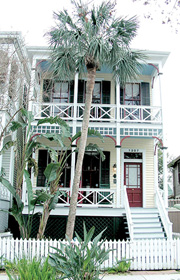Galveston: History’s Guardian

The leadership torch of historic preservation on Galveston Island—one of the Texas cities where history is felt most keenly has been passed. For only the fourth time, a new executive director has taken the helm of the Galveston Historical Foundation (GHF). This newest leader is a gay man, W. Dwayne Jones.
According to Bob Brown, chairman of the foundation search committee, Jones (who was selected by unanimous vote of the board of directors) exceeded all other candidates in his “. . .poise, experience, depth of training and knowledge of historic preservation, fundraising, event planning, neighborhood building, and organizational management.”
Jones, a native Texan who is actually named after his father, Wilmon, radiates these qualities with confidence upon first meeting. His educational background speaks for itself. Graduating from Trinity University in San Antonio with a bachelor’s degree in history and Asian studies, he then earned his master’s in urban and regional planning at George Washington University, Washington, D.C.
Jones’ career in historic preservation began in 1984, which gives him nearly 25 years of experience in the national preservation movement. After a stint in Maryland, he returned to the state of his birth to work in Wharton’s Main Street Program, and stayed. For 11 years, he worked for the Texas Historical Commission in various programs before moving to San Antonio to manage that city’s neighborhood planning division. Jones spent his last six years in Dallas as executive director of its nonprofit preservation group, working with the city to balance new development with old buildings.
He also worked at GHF briefly, in 1999 and 2000, as director of Preservation and Conservation Services, and considers this move as “coming full circle.” He feels strong family ties to the Island. Several of his ancestors came from England through the Port of Galveston to settle in central Texas. Unfortunately, some didn’t make it that far, as they died during the Battle of Galveston on January 1, 1863.
As for his new role at GHF, Jones states that he looks forward to working with a well respected and mature nonprofit preservation organization and leading it into “unexplored territory” statewide.

Indeed, the Texas Historical Commission recently honored the foundation for its long and successful record of historical preservation on the Island. Unveiling a marker at 20th and Postoffice streets on May 20, Jones presided at a brief ceremony, followed by a champagne toast to the oldest preservation group in the state, the largest such local organization in the nation, and the first in Texas to be officially recognized with a THC historical marker.
The plaque noted the foundation’s 1871 inception as the Historical Society, which a group of 12 men established to save the written documents and ephemera of both city and state origins. Stored at the Rosenberg Library in 1906, the collection became the library’s property in 1931. The society resurfaced again in 1942 to publish a booklet of the city’s significant houses in 1951. Three years later, when the Samuel May Williams home was threatened with demolition, the society formed the Galveston Historical Foundation to buy and restore it. The society and foundation merged in 1958, remaining somewhat dormant until 1966, when the board of directors authorized John Garner’s Historic American Buildings Survey. (See “Building a Foundation.”)
As the fourth executive director of the foundation, Jones holds the promise to equal or exceed his predecessors. He follows Marsh Davis, who led GHF only four years. During that time, Davis brought a definite professionalism to the organization before he returned home to Indiana to lead that state’s historic landmark foundation. Peter Brink, the first executive director of the foundation, successfully initiated every phase of historical preservation on the Island, beginning in 1973. He left Galveston in 1989 to accept a position with the National Trust for Historic Preservation but still maintains close contact with the Island. He left his second-in-command, Betty Massey, at the helm, until she moved on to the Mary Moody Northen Endowment in the fall of 2000. Her own second-in-command, Gina Spagnola, served as interim director until Davis arrived in 2002.
Jones “hit the ground running” as executive director on December 15, 2006, and hasn’t stopped yet, according to current honorary president, Bets Anderson. His ideas for the future of the foundation are numerous, and his vision extends across the causeway.
Jones noted during an interview that the Galveston Historical Foundation is the only historical preservation group with both land and water properties. He plans to increase attendance at these sites by improving the interpretive materials used by docents to make visitor experiences more interactive. In this way, he hopes that visitors will better connect to their history through a more personal experience.
Jones predicts some changes to the two major events that that foundation sponsors every year, Dickens on the Strand and the Historic Homes Tour. Jones envisions a revitalized Dickens, the foundation’s primary fundraiser, which in recent years has lost some of its original charm. He spoke of bringing back the “old flavor and ambiance” of the once-literary event, which takes place on the first weekend in December.
“It’s a special event because it has a unique setting and historical theme that is authentic to Galveston,” he said. “That needs to be in place year after year.”
Attendance at the annual Historic Homes Tour in May increased by 700 over previous years’ totals, primarily due to the first-ever inclusion of the Scottish Rite Masonic Cathedral and many small bungalows on the itinerary. To assure a repeat of the tour’s success, Jones wants to include more modern historic homes built between the ’30s and the ’50s, like those found in the Denver Court and Cedar Lawn districts.
A member of the American Institute of Certified Planners, Jones is especially concerned about new development encroaching upon old Galveston neighborhoods that remain, as yet, unprotected.
“It is important to set a solid course for preservation,” he wrote in a recent issue of Galveston Preservation News, “so that historic properties will not be compromised by other development objectives.”
Comfortable with where and who he is, the most affable, openly gay Jones doesn’t plan to leave Galveston anytime soon. He recently sold his house in Dallas and plans to invest in an Island historic residence of his own, just as he did when he previously worked in Galveston. At that time, he chose the East End Historical District. This time, he says he will live wherever he finds “just the right house” for his family.
The current loves of his life are his two show dogs. Already a champion, the elder salt-and-pepper standard Schauzer helps train his “brother by adoption,” a black three-year-old Portuguese Water Dog, who is still working on that distinction.
As for a human partner, Jones shrugged philosophically, saying in a rather Zen manner, “whatever” happens, happens. In the rare moments when he isn’t working or showing his dogs, he writes creative nonfiction.
Firmly committed to Galveston and passionate about its historic preservation, the new executive director stated, “As long as I am productive and a beneficial leader for the Galveston Historical Foundation, I will be here. I can’t think about ever stopping preserving some of the state’s finest historic resources. I’m not sure that’s possible.”
____________________________
Risky Business

The Galveston Historical Foundation recently released its Heritage At Risk List for 2007, calling attention to buildings and neighborhoods threatened with destruction.
“Our list is an effort of education and advocacy,” Galveston Historical Foundation executive director Dwayne Jones said when the list was announced in May. “By drawing awareness to properties that are in harm’s way, we further our prime mission of preserving Galveston’s heritage for everyone.”
The foundation has issued its annual list, modeled after the National Trust for Historic Preservation list of “America’s Most Endangered Places,” since 2003. The list for this year includes the following Galveston landmarks:
• Broadmoor Apartments
• Galveston Brewing Company complex
• Fire Station #3
• The Robles House in the East End
• Galveston’s alleys and back buildings
• Galveston’s corner stores
• East half of Hendley Row on The Strand
• Jean Lafitte Hotel
• Stewart Mansion on the West End
• Officers’ housing at Fort Crockett
• Traditional neighborhoods not protected by historic zoning designations.
More info: www.galvestonhistory.org
__________________________________
Building a Foundation
Insightful city fathers chose to build the city’s future on its past during the mid-1960s. The era of urban renewal that swept over the nation after World War II skipped over Galveston, leaving the city’s 19th- and early 20th-century structures standing, but barely. Funded by the Moody Foundation, the Kempner Fund, and private donations, the Historic American Buildings Survey through the U. S. Parks and Wildlife hired historic architect John C. Garner Jr. to conduct an investigation into the preservation potential of Galveston’s historic structures in 1966.
A Texas-born “authority on 19th-century architecture,” Garner (and his part-time secretary, Dorris Stechmann Johnson) conducted a block-by-block investigation of the city’s eastern third in October, listing its viable and valuable historic buildings. Galveston’s was the “first large-scale effort to focus community attention” toward “…a unified effort in preserving and protecting” its historical heritage as a way to enrich “…the appeal of sun and sea in holding visitors.” Coincidentally, Congress mandated a historic preservation program for the nation at the same time.
From his Galveston Architecture Inventory of 1,000 structures, Garner discovered a great number of significant structures still standing throughout the city that reflected every stage of its development, and deemed them “…worthy of preservation on the basis of historical, cultural, architectural, and educational merit.”
To further position the city at the forefront of the historic preservation movement, Garner launched a grassroots public-relations campaign in February 1967. From local groups to national politicians, he appealed to all, proposing that the Island city had the “wealth and will” to protect its historical heritage. His campaign reached its pinnacle when Secretary of the Interior Stewart Udall came to town that February. Amazed at the rich amount of history he found in Galveston, Udall stated, “You have something future generations will praise you for preserving.”
Garner then issued a mandate for the Galveston Historical Foundation, which included a Historic District Plan as a priority project. This became part of the mission of the foundation: “…stabilization of older neighborhoods into safe and attractive places to invest.” The first two areas to be recognized both nationally and locally were the central business district and the residential east end.
And the rest, as they say, is history.
Jan Johnson, who reported on the Island’s East End for our July 2006 issue (“East Side Story”), is completing a book on Galveston, scheduled for publication in the fall.











Comments